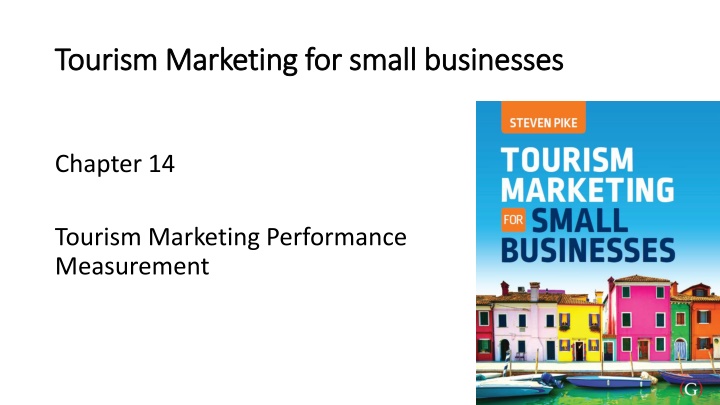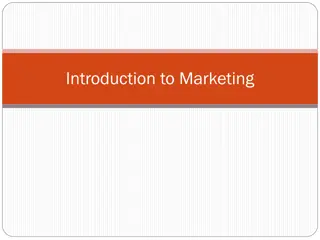Effective Tourism Marketing Performance Measurement Strategies for Small Businesses
Enhance your understanding of clear marketing performance indicators, approaches for evaluating promotion effectiveness, and consumer-based brand equity as a branding performance indicator over time. Learn about performance measurement challenges and essential techniques for small tourism businesses with limited promotional budgets.
Download Presentation

Please find below an Image/Link to download the presentation.
The content on the website is provided AS IS for your information and personal use only. It may not be sold, licensed, or shared on other websites without obtaining consent from the author.If you encounter any issues during the download, it is possible that the publisher has removed the file from their server.
You are allowed to download the files provided on this website for personal or commercial use, subject to the condition that they are used lawfully. All files are the property of their respective owners.
The content on the website is provided AS IS for your information and personal use only. It may not be sold, licensed, or shared on other websites without obtaining consent from the author.
E N D
Presentation Transcript
Tourism Marketing for small businesses Tourism Marketing for small businesses Chapter 14 Tourism Marketing Performance Measurement
Chapter learning aims Chapter learning aims To enhance your understanding of: the need for clear marketing performance indicators approaches for evaluating the effectiveness of promotions consumer-based brand equity as an indicator of branding performance over time
Key terms Key terms Performance measurement Evaluation of the extent to which an objective has been achieved. Marketing performance indicators Measurable markers used to evaluate effectiveness in achieving marketing objectives. Consumer-based brand equity (CBBE) A model for measuring the strength of a brand in consumers minds, over time, which analyses brand salience, brand image and brand loyalty.
Marketing performance measurement Marketing performance measurement Effective marketing performance measurement is essential for small tourism businesses Competing with relatively small promotional budgets Promotional spending must be monitored for effectiveness to ensure efficient and best use of resources While the ultimate marketing performance indicator is sales, there is a range of other quantitative and qualitative markers used to measure the outcomes of promotions, relative to the objectives Performance measurement can be quite complex, with the greatest challenge being to quantify the direct impact of different promotions on sales
To recap: Marketing planning To recap: Marketing planning Where are we now? (Situation analysis) Where do we want to go? (Objective setting) How do we get there? (Implementation of tactics) How will be know we got there? (Performance measurement)
Evaluating effectiveness of promotion Evaluating effectiveness of promotion 1. What is the marketing objective aligned with the promotion? 2. What is the current level of performance, in relation to the marketing objective? 3. What performance indicator(s) will be used to evaluate success?
Table 14.1 Table 14.1 Key marketing performance Key marketing performance indicators indicators Quantitative Qualitative Tracked through the business data Sales volume Sales value Yield Cost per enquiry Visitor numbers Length of stay Repeat visitation levels Occupancy rates Revenue per room Customer satisfaction scores Coupon/special code conversions Numbers of consumer enquiries Number of complaints Website metrics Social media metrics Email signups Customer feedback comments Digital and social media comments
Table 14.1 Table 14.1 Key marketing performance Key marketing performance indicators indicators Tracked through marketing research Equivalent advertising value (EAV) of media publicity Advertising recall Brand awareness Brand image Brand loyalty Consumer perceptions Travel trade perceptions Customer satisfaction Media editorial content Digital and social media comments
Evaluating advertising Evaluating advertising Not widely reported in the tourism literature Difficult Eg we know half of our advertising is working we just don t know which half Tracking the number of enquiries within a given time period Estimating the cost per enquiry Conversion studies Surveying the level of advertising recall and purchase intent
Evaluating PR and publicity seeking Evaluating PR and publicity seeking Most common is estimating the equivalent advertising value (EAV) EAV is a measure of what the published media editorial space would cost if purchased as an advertisement EAV can be applied to all traditional forms of media, such as newspapers, television and radio
EAV limitations EAV limitations While EAV is easy to measure, and can be an impressive metric to share with stakeholders, there are limitations. For example, EAV does not indicate: the content of the editorial the extent to which the editorial was positive how many of the audience noticed and paid attention to the story the extent to which the audience who did pay attention to the editorial represent the target market any resultant consumer action as a result of the editorial
Evaluating digital and social media Evaluating digital and social media Common KPIs: Counts, completions, page visits, shares, tweets, posts, time spent, viewable impressions, cost per mile (CPM), cost per click (CPC), click through rate (CTR) However these are not always related to sales eg vanity metrics What is the related objective? Does the metric help decision making? Social media listening platforms Facebook Analytics Google Analytics YouTube audience reports
Evaluating sales promotions Evaluating sales promotions Since these are short term sales incentives, effectiveness is easy to monitor: The number of enquiries during the promotion period The number of sales coupons redeemed The cost per redeemed coupon Ratio of total costs relative to total redeemed coupon sales
Evaluating trade and consumer expos Evaluating trade and consumer expos Trade contacts made can be contacted for feedback and sales pitches Sales from distribution channels easy to track Consumer expos are more challenging to evaluate the number of sales leads generated the number of promotional coupons with discount codes redeemed the ratio of total costs relative to total redeemed coupon sales the use of a competition can generate consumer contact details, for follow up contact, and for inclusion in a direct mail database
Measuring branding performance Measuring branding performance Consumer-based brand equity (CBBE) The power of the brand lies in the minds of consumers CBBE provides measures of past marketing performance and indicators of possible future performance Underpins the financial valuation of brand equity, an intangible asset value on the balance sheet Valuation of the business
Table 14.2 Table 14.2 CBBE dimensions relative to CBBE dimensions relative to marketing objectives marketing objectives CBBE dimension Marketing objective Brand salience To increase awareness of the brand Brand image To increase interest in the brand To educate the market about our offerings Brand loyalty To increase visitation To increase revisitation
Figure 14.1 Figure 14.1 Importance analysis analysis Importance- -performance performance Quadrant 1 Quadrant 2 Concentrate here Keep it up I m p o r t a n c e Quadrant 3 Quadrant 4 Low Priority Possible Overkill Performance
Monitoring visitor satisfaction Monitoring visitor satisfaction Increased customer satisfaction leads to increased financial performance Monitoring third party sites eg TripAdvisor Guests can be asked on-site, and via (e)mail surveys SERVQUAL is a ready made 22 item questionnaire Based on expectancy-disconfirmation theory Gap analysis of SERVQUAL visually highlights gaps between guests expectations and perceptions of performance
Figure 14.2 Figure 14.2 Gap analysis Gap analysis
Discussion questions Discussion questions The chapter shared an old marketing adage: We know half of our advertising is working we just don t know which half. Why is it so challenging to quantify the direct contribution of the entire promotion mix to sales? Why is performance measurement part of a cycle rather than the end point of marketing planning? Why is CBBE considered to provide an indicator of future performance?























